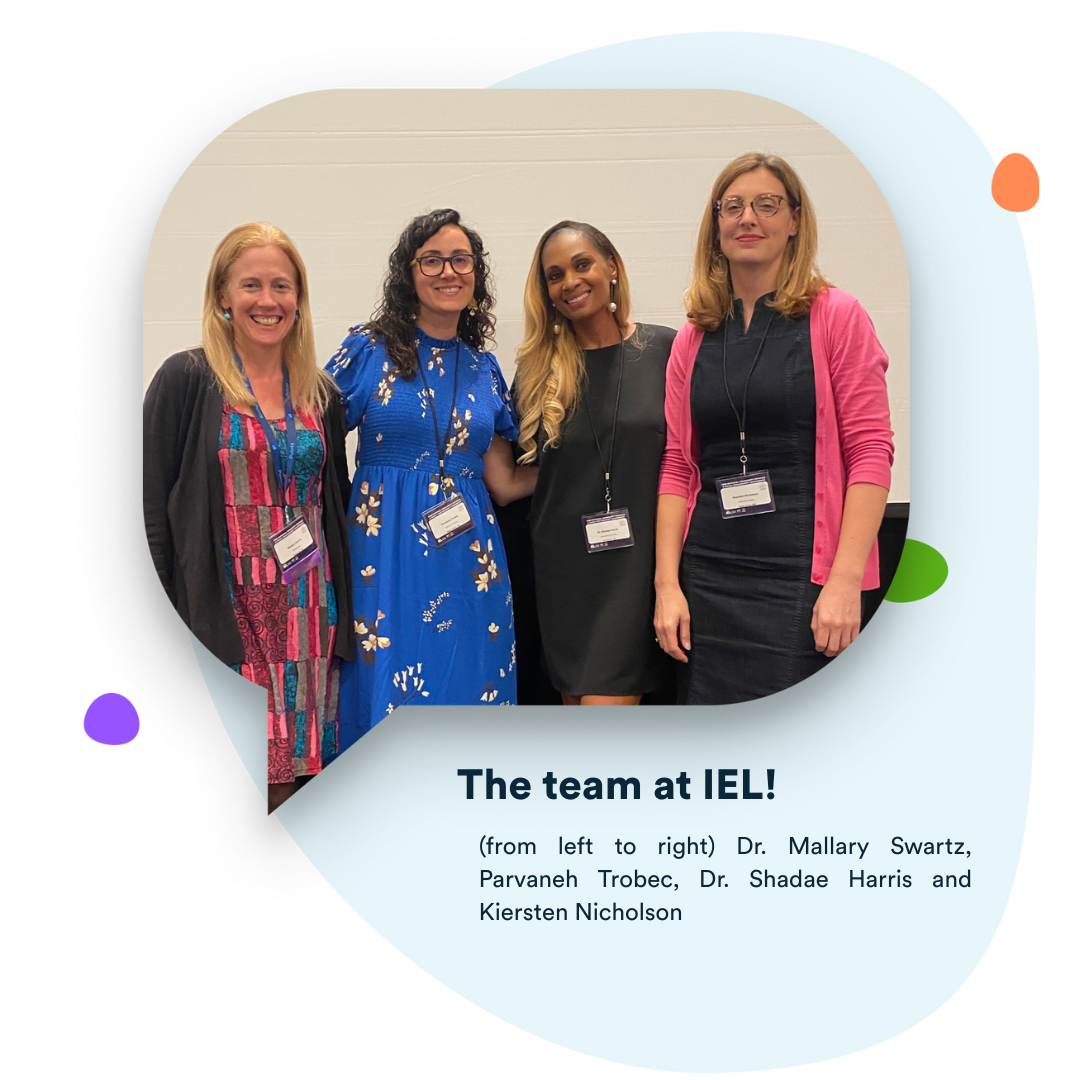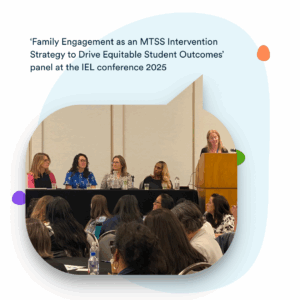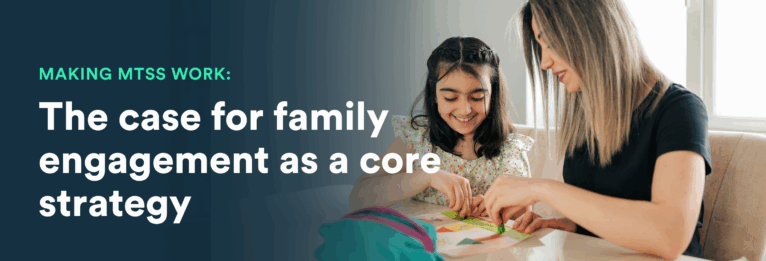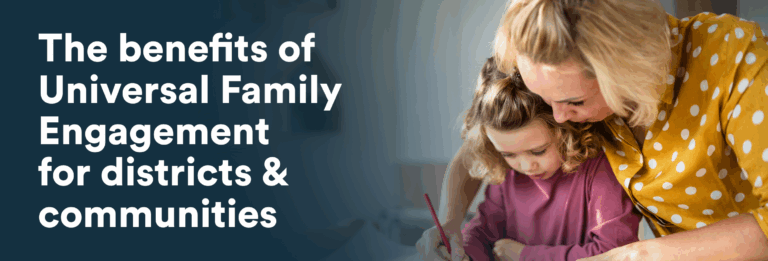Written by Dr. Mallary Swartz
At the 2025 National Community Schools and Family Engagement Conference, a passionate group of education leaders gathered around a shared vision: family engagement isn’t extra — it’s essential.
The session, “Family Engagement as an MTSS Intervention Strategy to Drive Equitable Student Outcomes,” brought together panelists who’ve been leading this work from classrooms to boardrooms:

- Dr. Mallary Swartz, Director of Research, TalkingPoints
- Dr. Shadae Harris, President & CEO, Groundwork Consulting
- Kiersten Nicholson and Parvaneh Trobec, Osseo Area Schools
- Dr. Hannah Frink, Perham-Dent Public Schools
Together, they made the case that when family engagement is designed as a universal, system-wide practice — not a stand-alone program — it can be a superpower for inclusion and student success.
What Is Universal Family Engagement?
The panel opened with a powerful reframing: Universal Family Engagement isn’t a program or one-time initiative—it’s a system-wide approach to building meaningful, consistent partnerships with every family, regardless of language, identity, or circumstance.
It moves beyond newsletters and back-to-school nights. It’s about embedding equity-driven engagement into how schools operate every day. That includes:
- Proactively removing barriers—like language, time, technology, and trust
- Creating inclusive, two-way communication that invites dialogue, not just updates
- Centering families as experts in their children’s lives, not as passive recipients
- Building engagement into the DNA of a district’s MTSS framework
As one panelist shared:
“It’s not about doing more. It’s about doing what matters—for every family, every time.”
Universal Family Engagement means seeing families not as a challenge to manage, but as a superpower to unlock—a foundational part of how we support student success at scale.
Why family engagement belongs in MTSS
Integrating engagement into Multi-Tiered Systems of Support drives results where they matter most. Panelists highlighted a growing body of research and lived experience demonstrating that when families are engaged, they actively contribute to:
- Higher attendance and academic achievement
- Improved student well-being
- Stronger school culture
- Greater equity in access and outcomes
TalkingPoints’ partnerships across the country reinforce this: consistent, inclusive communication strengthens the entire support system, especially for multilingual and historically underserved families.
![]()
Discover more about these strategies by watching the webinar:
Family Engagement Unlocks the Power of your MTSS Framework
Shifting the mindset

Embedding engagement into MTSS begins with changing our perspective on it. The panel encouraged attendees to adopt three critical mindset shifts:
- Engagement is a strategy, not a goal. It’s the how behind improved student outcomes.
- Digital and in-person tools must work together. One amplifies the other, and together, they meet families where they are.
- How we engage matters. Language access, cultural responsiveness, and tone are foundational, not optional.
When schools treat communication as a key instructional tool, rather than a transactional task, engagement becomes transformational.
The Engagement Essentials: Dr. Shadae Harris’s framework
One of the session’s most powerful moments came from Dr. Shadae Harris, who invited the room to reflect not just on what we do, but how and why we do it.
Dr. Harris shared the Engagement Essentials, a framework grounded in research and equity-centered design:
1. Honor history
Every family carries experiences, knowledge, and a personal narrative. As Dr. Harris noted,
“You are entering a narrative already in progress.”
Recognizing that history — not erasing it — is essential to building authentic trust.
2. Create the right conditions
Educators and leaders cultivate engagement by creating environments rooted in trust, respect, and belonging—places where families feel valued, not evaluated.
3. Build strong systems
Sustainable engagement can’t depend on a few passionate individuals. It requires infrastructure: clear roles, shared language, ongoing training, and tools like TalkingPoints that help make meaningful connection possible for every educator and every family.
4. Invest in practice
Just as strong instruction requires support, so does strong engagement. Schools must equip educators and families alike with the time, resources, and confidence to connect meaningfully — and often.
She closed with a quote that resonated throughout the room:
“You do not rise to the level of your goals. You fall to the level of your systems.”
From vision to practice: District spotlights
Two district partners — Perham-Dent and Osseo Area Schools — shared how they’re making this work real. Their stories reminded us that engagement isn’t abstract. It’s personal, practical, and powerful.
? Perham-Dent Public Schools in Minnesota
Set in a rural Minnesota community surrounded by lakes and small-town values, Perham-Dent serves about 1,800 students across four schools. Their size and close-knit culture are strengths, but like many districts, they faced challenges connecting with all families.
The challenge:
- Limited communication access for multilingual families
- Over-reliance on one educator to manage outreach
- Gaps in trust and inclusion across the school community
The solution:
- Introduced two-way translated messaging with TalkingPoints
- Held community meetings in culturally meaningful venues
- Built ongoing follow-up and dialogue into their engagement plan
The impact:
- A 10% drop in high school absenteeism
- Native American program attendance grew from a handful to over 60 families
- One student’s attendance skyrocketed from 33% to 87%
Perham-Dent’s success didn’t come from flashy initiatives — it came from building trust, listening deeply, and removing systemic barriers.
“Once families felt invited — not just informed — they showed up. And so did their students.”
? Osseo Area Schools in Minnesota
In suburban Minneapolis, Osseo is one of Minnesota’s largest and most linguistically diverse school districts. With over 125 languages spoken across its schools, engaging every family requires more than translation — it requires infrastructure and intentionality.
The challenge:
- Communication wasn’t consistently accessible
- Engagement relied heavily on a few bilingual staff
- Some families felt disconnected from events and decision-making
The solution:
- Adopted TalkingPoints district-wide to ensure every family could communicate in their home language
- Provided professional development to help educators move from outreach to partnership
- Shifted engagement from scattered efforts to a coherent, system-wide strategy
The impact:
- Higher attendance at school events
- Deeper relationships between families and educators
- Endorsements from both leadership and families
“I love TalkingPoints. I think it’s a great addition — because it’s easy, and a text!” — Kelsey Dawson, School Board Member & Parent
Osseo’s story shows that when communication is built into the system, equity becomes possible and sustainable.
Moving forward
As the session closed, the presenters invited attendees to reflect:
- What mindset or system shift is your district ready for?
- What’s one condition you can strengthen to support more inclusive engagement?
- What’s one action you’ll take in the next 30 days to move from intention to implementation?
Their message was clear: family engagement is not a standalone goal — it’s a strategy for lasting change. And when integrated into MTSS, it helps every student, every family, and every school community thrive.
At TalkingPoints, we’re committed to helping districts make this shift through evidence-based tools, partnerships, and the belief that everyone benefits when families are engaged.
![]()
See TalkingPoints in action—watch a 90-second explainer video.
![]()
Celebrating 10 years of partnership and impact
For a decade, TalkingPoints has supported students, families, and educators through the power of effective family-school partnerships. As an education technology nonprofit, our award-winning communication and family engagement platform has improved outcomes for districts and students across the country.
We connect 9 million+ educators, students, and family members annually and have facilitated more than one billion conversations—building trust, fostering relationships, and fueling student success. Named by Common Sense Education as “the best overall family communication platform for teachers and schools,” TalkingPoints drives measurable gains in attendance and academic achievement, backed by rigorous, causal research.
Join us in building a future where every child has the support they need to thrive.



